Project Management - Analysis of Project Teams and Planning
VerifiedAdded on 2020/01/07
|20
|6163
|433
Project
AI Summary
This project management assignment explores key concepts and practices essential for effective project execution. Task 1 focuses on defining 'project' and 'project management,' identifying ways to determine project success, and outlining the seven phases and nine principles of the Dynamic Systems Development Method (DSDM). It also addresses factors that lead to project termination. Task 2 delves into project team structures, analyzing the strengths and weaknesses of various organizational setups. It also examines the challenges faced by project managers in IT projects and the essential qualities of an efficient project manager. Task 3 covers the contents of a project plan, the assessment of project activities, attributes of an auditor, and the elements of a change control system. The assignment provides a comprehensive overview of project planning, team management, and control mechanisms, offering valuable insights for students studying project management.
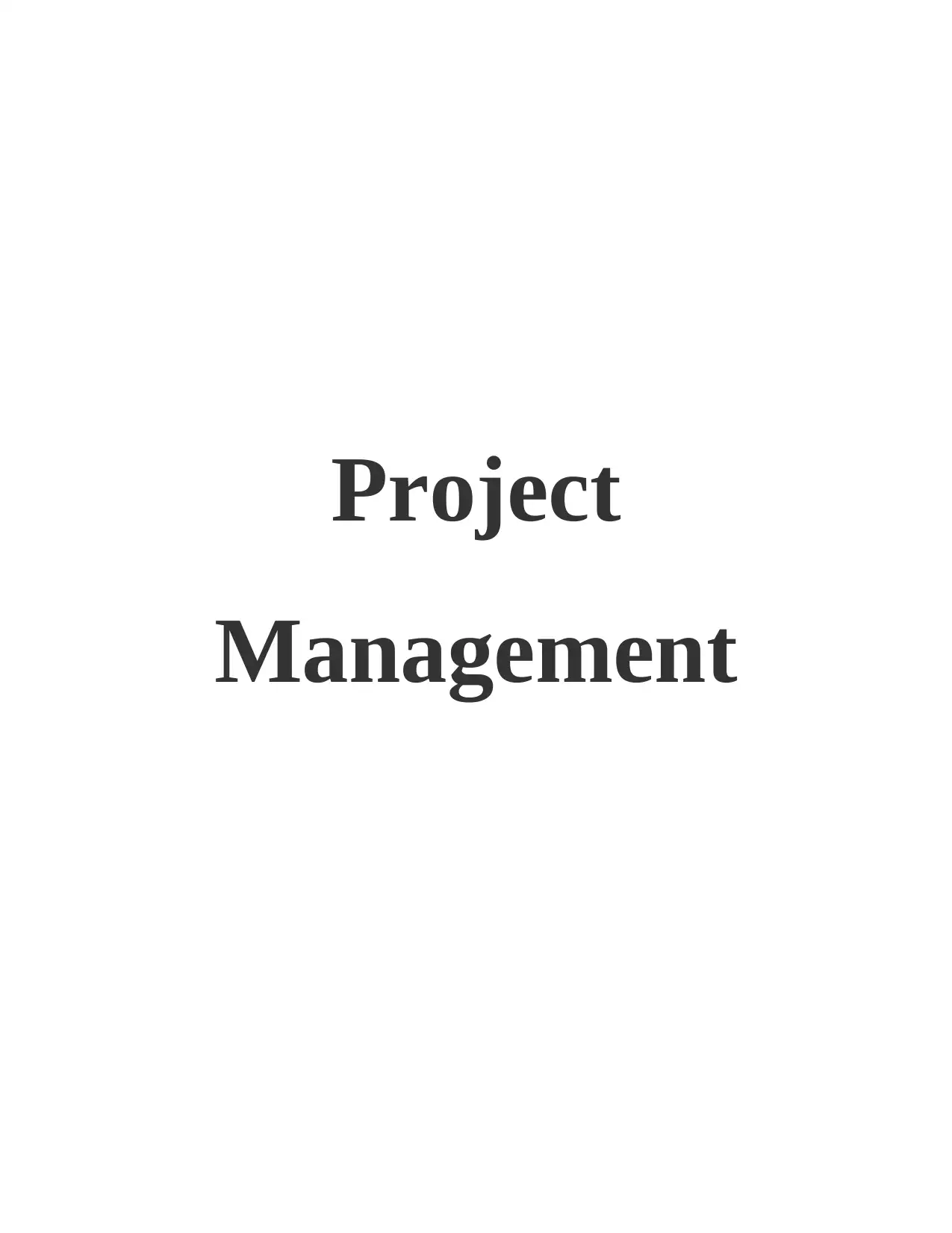
Project
Management
Management
Paraphrase This Document
Need a fresh take? Get an instant paraphrase of this document with our AI Paraphraser
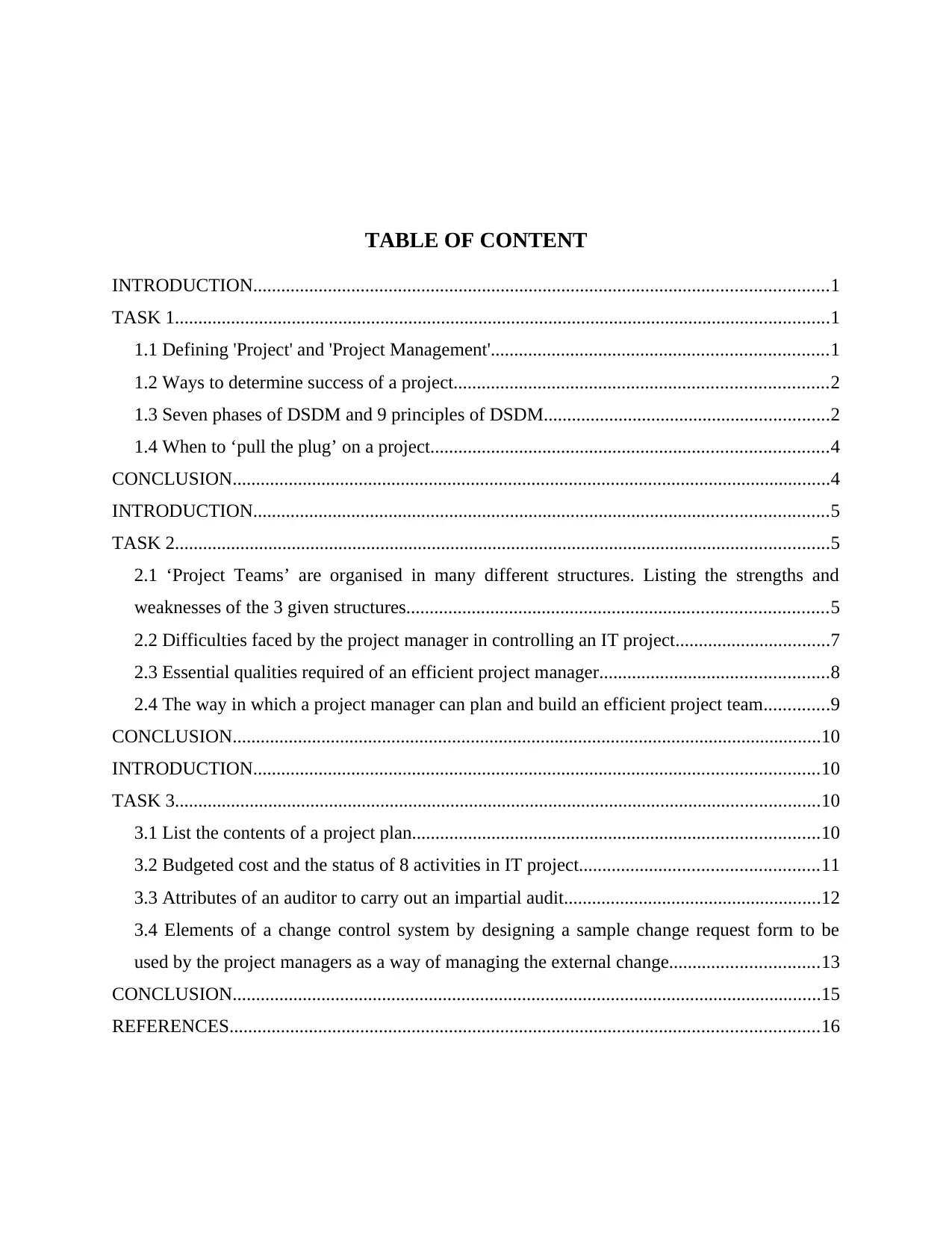
TABLE OF CONTENT
INTRODUCTION...........................................................................................................................1
TASK 1............................................................................................................................................1
1.1 Defining 'Project' and 'Project Management'........................................................................1
1.2 Ways to determine success of a project................................................................................2
1.3 Seven phases of DSDM and 9 principles of DSDM.............................................................2
1.4 When to ‘pull the plug’ on a project.....................................................................................4
CONCLUSION................................................................................................................................4
INTRODUCTION...........................................................................................................................5
TASK 2............................................................................................................................................5
2.1 ‘Project Teams’ are organised in many different structures. Listing the strengths and
weaknesses of the 3 given structures..........................................................................................5
2.2 Difficulties faced by the project manager in controlling an IT project.................................7
2.3 Essential qualities required of an efficient project manager.................................................8
2.4 The way in which a project manager can plan and build an efficient project team..............9
CONCLUSION..............................................................................................................................10
INTRODUCTION.........................................................................................................................10
TASK 3..........................................................................................................................................10
3.1 List the contents of a project plan.......................................................................................10
3.2 Budgeted cost and the status of 8 activities in IT project...................................................11
3.3 Attributes of an auditor to carry out an impartial audit.......................................................12
3.4 Elements of a change control system by designing a sample change request form to be
used by the project managers as a way of managing the external change................................13
CONCLUSION..............................................................................................................................15
REFERENCES..............................................................................................................................16
INTRODUCTION...........................................................................................................................1
TASK 1............................................................................................................................................1
1.1 Defining 'Project' and 'Project Management'........................................................................1
1.2 Ways to determine success of a project................................................................................2
1.3 Seven phases of DSDM and 9 principles of DSDM.............................................................2
1.4 When to ‘pull the plug’ on a project.....................................................................................4
CONCLUSION................................................................................................................................4
INTRODUCTION...........................................................................................................................5
TASK 2............................................................................................................................................5
2.1 ‘Project Teams’ are organised in many different structures. Listing the strengths and
weaknesses of the 3 given structures..........................................................................................5
2.2 Difficulties faced by the project manager in controlling an IT project.................................7
2.3 Essential qualities required of an efficient project manager.................................................8
2.4 The way in which a project manager can plan and build an efficient project team..............9
CONCLUSION..............................................................................................................................10
INTRODUCTION.........................................................................................................................10
TASK 3..........................................................................................................................................10
3.1 List the contents of a project plan.......................................................................................10
3.2 Budgeted cost and the status of 8 activities in IT project...................................................11
3.3 Attributes of an auditor to carry out an impartial audit.......................................................12
3.4 Elements of a change control system by designing a sample change request form to be
used by the project managers as a way of managing the external change................................13
CONCLUSION..............................................................................................................................15
REFERENCES..............................................................................................................................16
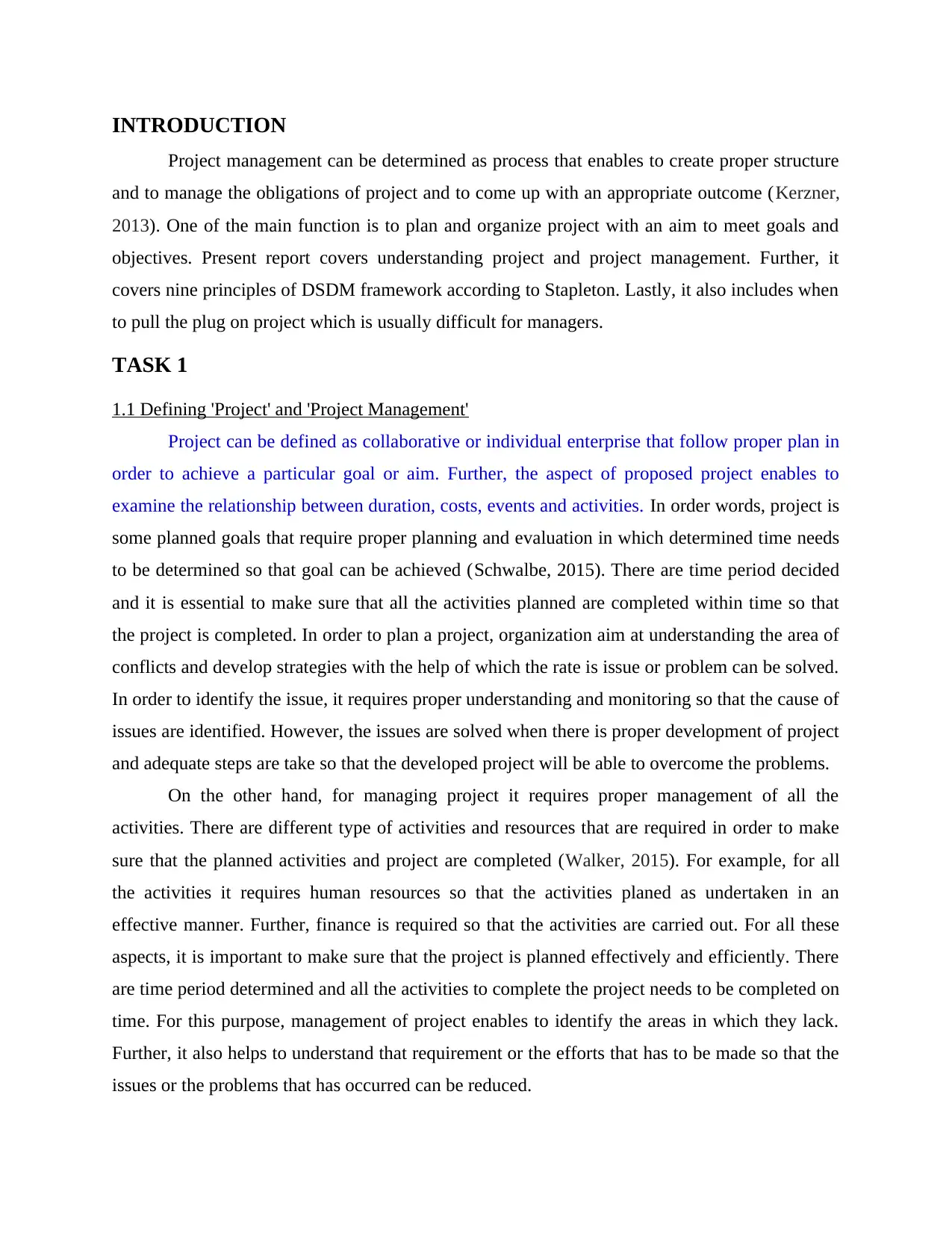
INTRODUCTION
Project management can be determined as process that enables to create proper structure
and to manage the obligations of project and to come up with an appropriate outcome (Kerzner,
2013). One of the main function is to plan and organize project with an aim to meet goals and
objectives. Present report covers understanding project and project management. Further, it
covers nine principles of DSDM framework according to Stapleton. Lastly, it also includes when
to pull the plug on project which is usually difficult for managers.
TASK 1
1.1 Defining 'Project' and 'Project Management'
Project can be defined as collaborative or individual enterprise that follow proper plan in
order to achieve a particular goal or aim. Further, the aspect of proposed project enables to
examine the relationship between duration, costs, events and activities. In order words, project is
some planned goals that require proper planning and evaluation in which determined time needs
to be determined so that goal can be achieved (Schwalbe, 2015). There are time period decided
and it is essential to make sure that all the activities planned are completed within time so that
the project is completed. In order to plan a project, organization aim at understanding the area of
conflicts and develop strategies with the help of which the rate is issue or problem can be solved.
In order to identify the issue, it requires proper understanding and monitoring so that the cause of
issues are identified. However, the issues are solved when there is proper development of project
and adequate steps are take so that the developed project will be able to overcome the problems.
On the other hand, for managing project it requires proper management of all the
activities. There are different type of activities and resources that are required in order to make
sure that the planned activities and project are completed (Walker, 2015). For example, for all
the activities it requires human resources so that the activities planed as undertaken in an
effective manner. Further, finance is required so that the activities are carried out. For all these
aspects, it is important to make sure that the project is planned effectively and efficiently. There
are time period determined and all the activities to complete the project needs to be completed on
time. For this purpose, management of project enables to identify the areas in which they lack.
Further, it also helps to understand that requirement or the efforts that has to be made so that the
issues or the problems that has occurred can be reduced.
Project management can be determined as process that enables to create proper structure
and to manage the obligations of project and to come up with an appropriate outcome (Kerzner,
2013). One of the main function is to plan and organize project with an aim to meet goals and
objectives. Present report covers understanding project and project management. Further, it
covers nine principles of DSDM framework according to Stapleton. Lastly, it also includes when
to pull the plug on project which is usually difficult for managers.
TASK 1
1.1 Defining 'Project' and 'Project Management'
Project can be defined as collaborative or individual enterprise that follow proper plan in
order to achieve a particular goal or aim. Further, the aspect of proposed project enables to
examine the relationship between duration, costs, events and activities. In order words, project is
some planned goals that require proper planning and evaluation in which determined time needs
to be determined so that goal can be achieved (Schwalbe, 2015). There are time period decided
and it is essential to make sure that all the activities planned are completed within time so that
the project is completed. In order to plan a project, organization aim at understanding the area of
conflicts and develop strategies with the help of which the rate is issue or problem can be solved.
In order to identify the issue, it requires proper understanding and monitoring so that the cause of
issues are identified. However, the issues are solved when there is proper development of project
and adequate steps are take so that the developed project will be able to overcome the problems.
On the other hand, for managing project it requires proper management of all the
activities. There are different type of activities and resources that are required in order to make
sure that the planned activities and project are completed (Walker, 2015). For example, for all
the activities it requires human resources so that the activities planed as undertaken in an
effective manner. Further, finance is required so that the activities are carried out. For all these
aspects, it is important to make sure that the project is planned effectively and efficiently. There
are time period determined and all the activities to complete the project needs to be completed on
time. For this purpose, management of project enables to identify the areas in which they lack.
Further, it also helps to understand that requirement or the efforts that has to be made so that the
issues or the problems that has occurred can be reduced.
⊘ This is a preview!⊘
Do you want full access?
Subscribe today to unlock all pages.

Trusted by 1+ million students worldwide
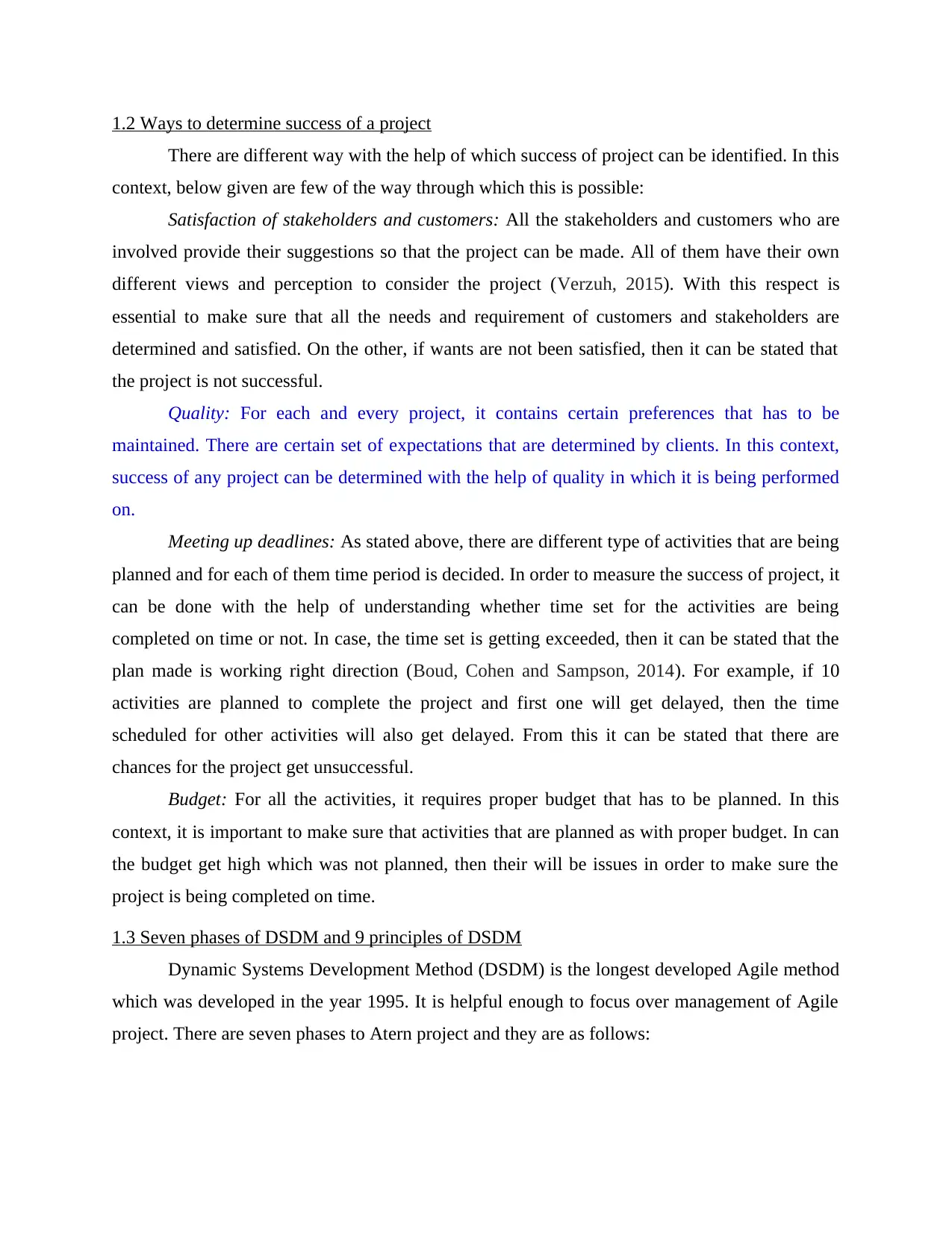
1.2 Ways to determine success of a project
There are different way with the help of which success of project can be identified. In this
context, below given are few of the way through which this is possible:
Satisfaction of stakeholders and customers: All the stakeholders and customers who are
involved provide their suggestions so that the project can be made. All of them have their own
different views and perception to consider the project (Verzuh, 2015). With this respect is
essential to make sure that all the needs and requirement of customers and stakeholders are
determined and satisfied. On the other, if wants are not been satisfied, then it can be stated that
the project is not successful.
Quality: For each and every project, it contains certain preferences that has to be
maintained. There are certain set of expectations that are determined by clients. In this context,
success of any project can be determined with the help of quality in which it is being performed
on.
Meeting up deadlines: As stated above, there are different type of activities that are being
planned and for each of them time period is decided. In order to measure the success of project, it
can be done with the help of understanding whether time set for the activities are being
completed on time or not. In case, the time set is getting exceeded, then it can be stated that the
plan made is working right direction (Boud, Cohen and Sampson, 2014). For example, if 10
activities are planned to complete the project and first one will get delayed, then the time
scheduled for other activities will also get delayed. From this it can be stated that there are
chances for the project get unsuccessful.
Budget: For all the activities, it requires proper budget that has to be planned. In this
context, it is important to make sure that activities that are planned as with proper budget. In can
the budget get high which was not planned, then their will be issues in order to make sure the
project is being completed on time.
1.3 Seven phases of DSDM and 9 principles of DSDM
Dynamic Systems Development Method (DSDM) is the longest developed Agile method
which was developed in the year 1995. It is helpful enough to focus over management of Agile
project. There are seven phases to Atern project and they are as follows:
There are different way with the help of which success of project can be identified. In this
context, below given are few of the way through which this is possible:
Satisfaction of stakeholders and customers: All the stakeholders and customers who are
involved provide their suggestions so that the project can be made. All of them have their own
different views and perception to consider the project (Verzuh, 2015). With this respect is
essential to make sure that all the needs and requirement of customers and stakeholders are
determined and satisfied. On the other, if wants are not been satisfied, then it can be stated that
the project is not successful.
Quality: For each and every project, it contains certain preferences that has to be
maintained. There are certain set of expectations that are determined by clients. In this context,
success of any project can be determined with the help of quality in which it is being performed
on.
Meeting up deadlines: As stated above, there are different type of activities that are being
planned and for each of them time period is decided. In order to measure the success of project, it
can be done with the help of understanding whether time set for the activities are being
completed on time or not. In case, the time set is getting exceeded, then it can be stated that the
plan made is working right direction (Boud, Cohen and Sampson, 2014). For example, if 10
activities are planned to complete the project and first one will get delayed, then the time
scheduled for other activities will also get delayed. From this it can be stated that there are
chances for the project get unsuccessful.
Budget: For all the activities, it requires proper budget that has to be planned. In this
context, it is important to make sure that activities that are planned as with proper budget. In can
the budget get high which was not planned, then their will be issues in order to make sure the
project is being completed on time.
1.3 Seven phases of DSDM and 9 principles of DSDM
Dynamic Systems Development Method (DSDM) is the longest developed Agile method
which was developed in the year 1995. It is helpful enough to focus over management of Agile
project. There are seven phases to Atern project and they are as follows:
Paraphrase This Document
Need a fresh take? Get an instant paraphrase of this document with our AI Paraphraser
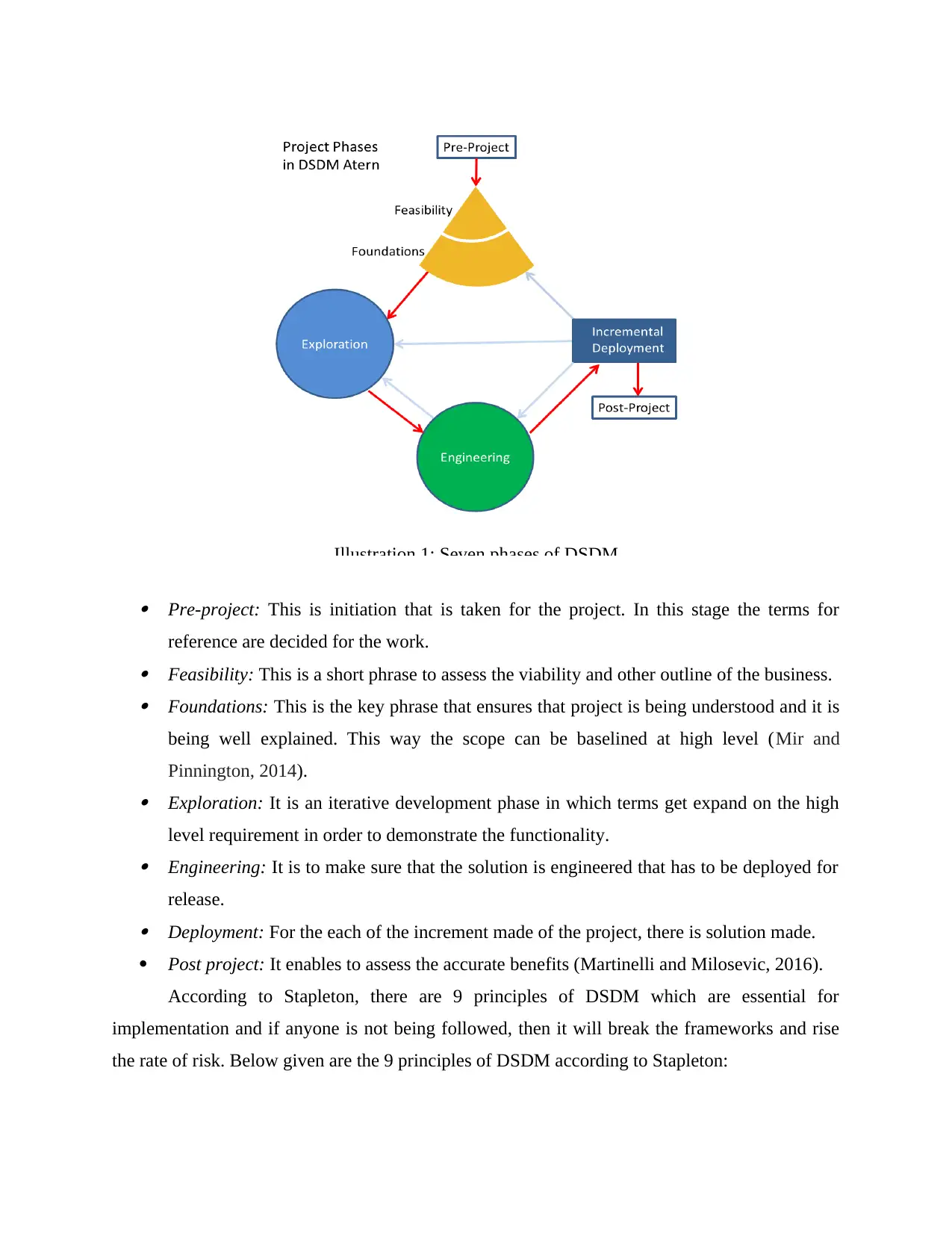
Pre-project: This is initiation that is taken for the project. In this stage the terms for
reference are decided for the work. Feasibility: This is a short phrase to assess the viability and other outline of the business. Foundations: This is the key phrase that ensures that project is being understood and it is
being well explained. This way the scope can be baselined at high level (Mir and
Pinnington, 2014). Exploration: It is an iterative development phase in which terms get expand on the high
level requirement in order to demonstrate the functionality. Engineering: It is to make sure that the solution is engineered that has to be deployed for
release. Deployment: For the each of the increment made of the project, there is solution made.
Post project: It enables to assess the accurate benefits (Martinelli and Milosevic, 2016).
According to Stapleton, there are 9 principles of DSDM which are essential for
implementation and if anyone is not being followed, then it will break the frameworks and rise
the rate of risk. Below given are the 9 principles of DSDM according to Stapleton:
Illustration 1: Seven phases of DSDM
reference are decided for the work. Feasibility: This is a short phrase to assess the viability and other outline of the business. Foundations: This is the key phrase that ensures that project is being understood and it is
being well explained. This way the scope can be baselined at high level (Mir and
Pinnington, 2014). Exploration: It is an iterative development phase in which terms get expand on the high
level requirement in order to demonstrate the functionality. Engineering: It is to make sure that the solution is engineered that has to be deployed for
release. Deployment: For the each of the increment made of the project, there is solution made.
Post project: It enables to assess the accurate benefits (Martinelli and Milosevic, 2016).
According to Stapleton, there are 9 principles of DSDM which are essential for
implementation and if anyone is not being followed, then it will break the frameworks and rise
the rate of risk. Below given are the 9 principles of DSDM according to Stapleton:
Illustration 1: Seven phases of DSDM
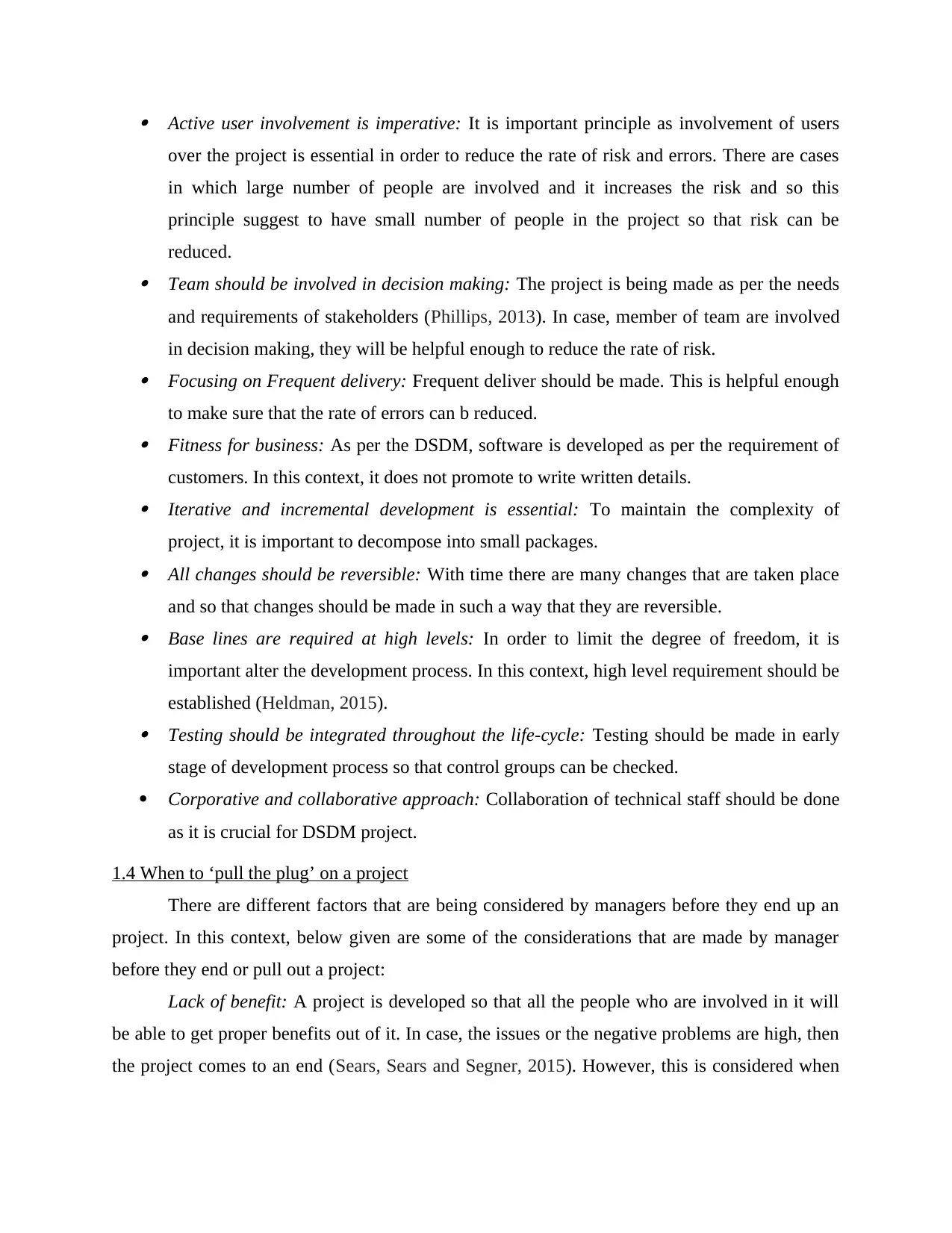
Active user involvement is imperative: It is important principle as involvement of users
over the project is essential in order to reduce the rate of risk and errors. There are cases
in which large number of people are involved and it increases the risk and so this
principle suggest to have small number of people in the project so that risk can be
reduced. Team should be involved in decision making: The project is being made as per the needs
and requirements of stakeholders (Phillips, 2013). In case, member of team are involved
in decision making, they will be helpful enough to reduce the rate of risk. Focusing on Frequent delivery: Frequent deliver should be made. This is helpful enough
to make sure that the rate of errors can b reduced. Fitness for business: As per the DSDM, software is developed as per the requirement of
customers. In this context, it does not promote to write written details. Iterative and incremental development is essential: To maintain the complexity of
project, it is important to decompose into small packages. All changes should be reversible: With time there are many changes that are taken place
and so that changes should be made in such a way that they are reversible. Base lines are required at high levels: In order to limit the degree of freedom, it is
important alter the development process. In this context, high level requirement should be
established (Heldman, 2015). Testing should be integrated throughout the life-cycle: Testing should be made in early
stage of development process so that control groups can be checked.
Corporative and collaborative approach: Collaboration of technical staff should be done
as it is crucial for DSDM project.
1.4 When to ‘pull the plug’ on a project
There are different factors that are being considered by managers before they end up an
project. In this context, below given are some of the considerations that are made by manager
before they end or pull out a project:
Lack of benefit: A project is developed so that all the people who are involved in it will
be able to get proper benefits out of it. In case, the issues or the negative problems are high, then
the project comes to an end (Sears, Sears and Segner, 2015). However, this is considered when
over the project is essential in order to reduce the rate of risk and errors. There are cases
in which large number of people are involved and it increases the risk and so this
principle suggest to have small number of people in the project so that risk can be
reduced. Team should be involved in decision making: The project is being made as per the needs
and requirements of stakeholders (Phillips, 2013). In case, member of team are involved
in decision making, they will be helpful enough to reduce the rate of risk. Focusing on Frequent delivery: Frequent deliver should be made. This is helpful enough
to make sure that the rate of errors can b reduced. Fitness for business: As per the DSDM, software is developed as per the requirement of
customers. In this context, it does not promote to write written details. Iterative and incremental development is essential: To maintain the complexity of
project, it is important to decompose into small packages. All changes should be reversible: With time there are many changes that are taken place
and so that changes should be made in such a way that they are reversible. Base lines are required at high levels: In order to limit the degree of freedom, it is
important alter the development process. In this context, high level requirement should be
established (Heldman, 2015). Testing should be integrated throughout the life-cycle: Testing should be made in early
stage of development process so that control groups can be checked.
Corporative and collaborative approach: Collaboration of technical staff should be done
as it is crucial for DSDM project.
1.4 When to ‘pull the plug’ on a project
There are different factors that are being considered by managers before they end up an
project. In this context, below given are some of the considerations that are made by manager
before they end or pull out a project:
Lack of benefit: A project is developed so that all the people who are involved in it will
be able to get proper benefits out of it. In case, the issues or the negative problems are high, then
the project comes to an end (Sears, Sears and Segner, 2015). However, this is considered when
⊘ This is a preview!⊘
Do you want full access?
Subscribe today to unlock all pages.

Trusted by 1+ million students worldwide
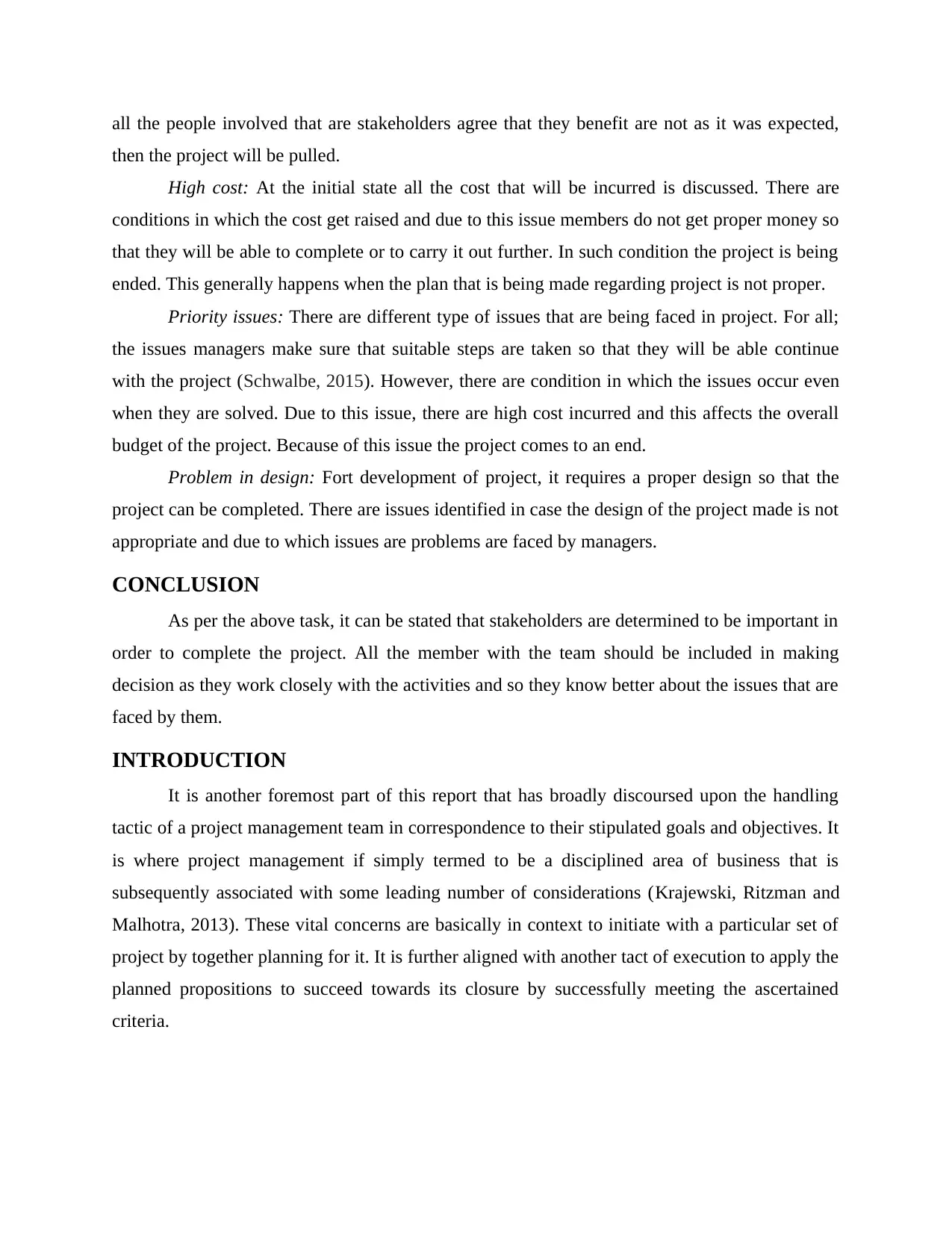
all the people involved that are stakeholders agree that they benefit are not as it was expected,
then the project will be pulled.
High cost: At the initial state all the cost that will be incurred is discussed. There are
conditions in which the cost get raised and due to this issue members do not get proper money so
that they will be able to complete or to carry it out further. In such condition the project is being
ended. This generally happens when the plan that is being made regarding project is not proper.
Priority issues: There are different type of issues that are being faced in project. For all;
the issues managers make sure that suitable steps are taken so that they will be able continue
with the project (Schwalbe, 2015). However, there are condition in which the issues occur even
when they are solved. Due to this issue, there are high cost incurred and this affects the overall
budget of the project. Because of this issue the project comes to an end.
Problem in design: Fort development of project, it requires a proper design so that the
project can be completed. There are issues identified in case the design of the project made is not
appropriate and due to which issues are problems are faced by managers.
CONCLUSION
As per the above task, it can be stated that stakeholders are determined to be important in
order to complete the project. All the member with the team should be included in making
decision as they work closely with the activities and so they know better about the issues that are
faced by them.
INTRODUCTION
It is another foremost part of this report that has broadly discoursed upon the handling
tactic of a project management team in correspondence to their stipulated goals and objectives. It
is where project management if simply termed to be a disciplined area of business that is
subsequently associated with some leading number of considerations (Krajewski, Ritzman and
Malhotra, 2013). These vital concerns are basically in context to initiate with a particular set of
project by together planning for it. It is further aligned with another tact of execution to apply the
planned propositions to succeed towards its closure by successfully meeting the ascertained
criteria.
then the project will be pulled.
High cost: At the initial state all the cost that will be incurred is discussed. There are
conditions in which the cost get raised and due to this issue members do not get proper money so
that they will be able to complete or to carry it out further. In such condition the project is being
ended. This generally happens when the plan that is being made regarding project is not proper.
Priority issues: There are different type of issues that are being faced in project. For all;
the issues managers make sure that suitable steps are taken so that they will be able continue
with the project (Schwalbe, 2015). However, there are condition in which the issues occur even
when they are solved. Due to this issue, there are high cost incurred and this affects the overall
budget of the project. Because of this issue the project comes to an end.
Problem in design: Fort development of project, it requires a proper design so that the
project can be completed. There are issues identified in case the design of the project made is not
appropriate and due to which issues are problems are faced by managers.
CONCLUSION
As per the above task, it can be stated that stakeholders are determined to be important in
order to complete the project. All the member with the team should be included in making
decision as they work closely with the activities and so they know better about the issues that are
faced by them.
INTRODUCTION
It is another foremost part of this report that has broadly discoursed upon the handling
tactic of a project management team in correspondence to their stipulated goals and objectives. It
is where project management if simply termed to be a disciplined area of business that is
subsequently associated with some leading number of considerations (Krajewski, Ritzman and
Malhotra, 2013). These vital concerns are basically in context to initiate with a particular set of
project by together planning for it. It is further aligned with another tact of execution to apply the
planned propositions to succeed towards its closure by successfully meeting the ascertained
criteria.
Paraphrase This Document
Need a fresh take? Get an instant paraphrase of this document with our AI Paraphraser
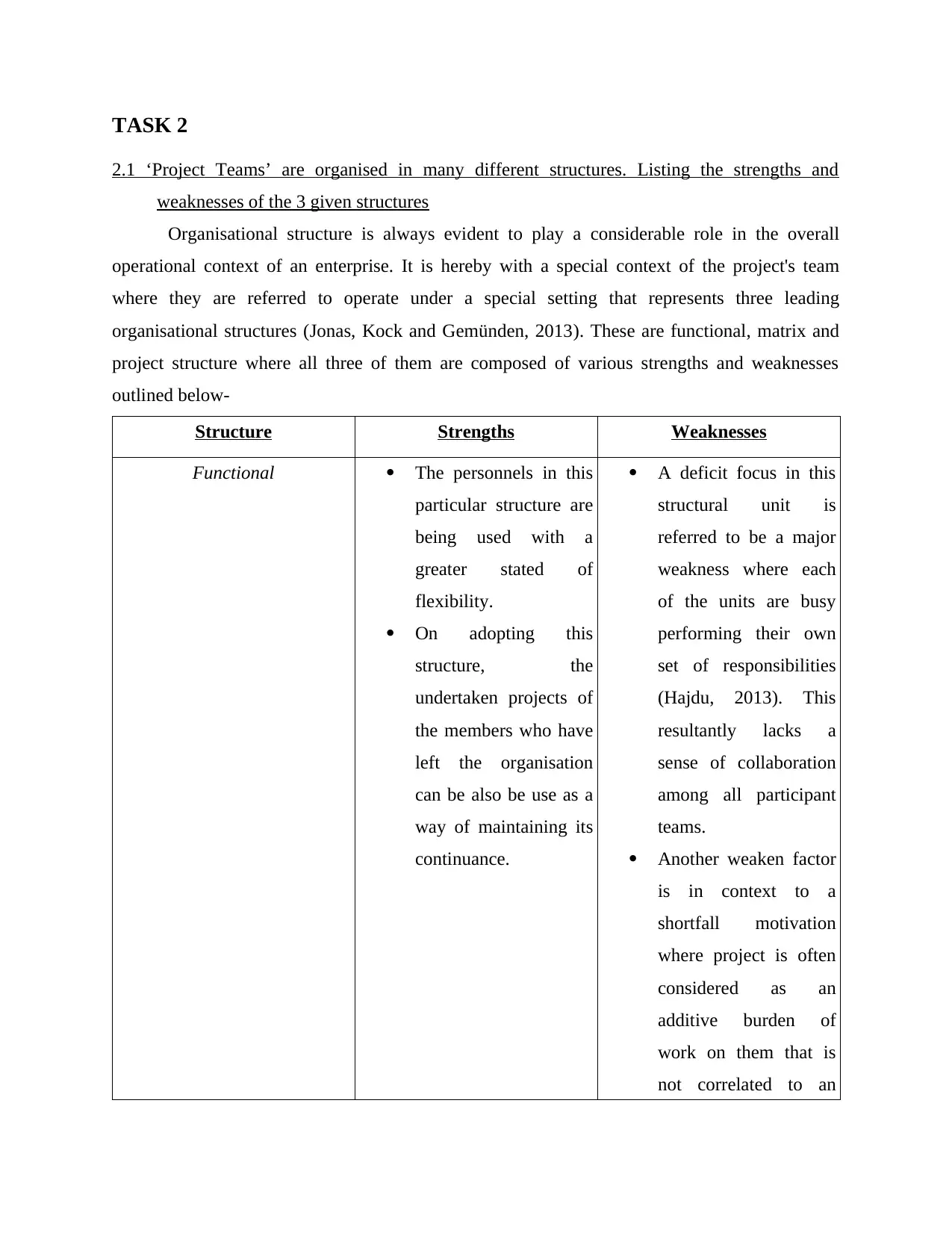
TASK 2
2.1 ‘Project Teams’ are organised in many different structures. Listing the strengths and
weaknesses of the 3 given structures
Organisational structure is always evident to play a considerable role in the overall
operational context of an enterprise. It is hereby with a special context of the project's team
where they are referred to operate under a special setting that represents three leading
organisational structures (Jonas, Kock and Gemünden, 2013). These are functional, matrix and
project structure where all three of them are composed of various strengths and weaknesses
outlined below-
Structure Strengths Weaknesses
Functional The personnels in this
particular structure are
being used with a
greater stated of
flexibility.
On adopting this
structure, the
undertaken projects of
the members who have
left the organisation
can be also be use as a
way of maintaining its
continuance.
A deficit focus in this
structural unit is
referred to be a major
weakness where each
of the units are busy
performing their own
set of responsibilities
(Hajdu, 2013). This
resultantly lacks a
sense of collaboration
among all participant
teams.
Another weaken factor
is in context to a
shortfall motivation
where project is often
considered as an
additive burden of
work on them that is
not correlated to an
2.1 ‘Project Teams’ are organised in many different structures. Listing the strengths and
weaknesses of the 3 given structures
Organisational structure is always evident to play a considerable role in the overall
operational context of an enterprise. It is hereby with a special context of the project's team
where they are referred to operate under a special setting that represents three leading
organisational structures (Jonas, Kock and Gemünden, 2013). These are functional, matrix and
project structure where all three of them are composed of various strengths and weaknesses
outlined below-
Structure Strengths Weaknesses
Functional The personnels in this
particular structure are
being used with a
greater stated of
flexibility.
On adopting this
structure, the
undertaken projects of
the members who have
left the organisation
can be also be use as a
way of maintaining its
continuance.
A deficit focus in this
structural unit is
referred to be a major
weakness where each
of the units are busy
performing their own
set of responsibilities
(Hajdu, 2013). This
resultantly lacks a
sense of collaboration
among all participant
teams.
Another weaken factor
is in context to a
shortfall motivation
where project is often
considered as an
additive burden of
work on them that is
not correlated to an
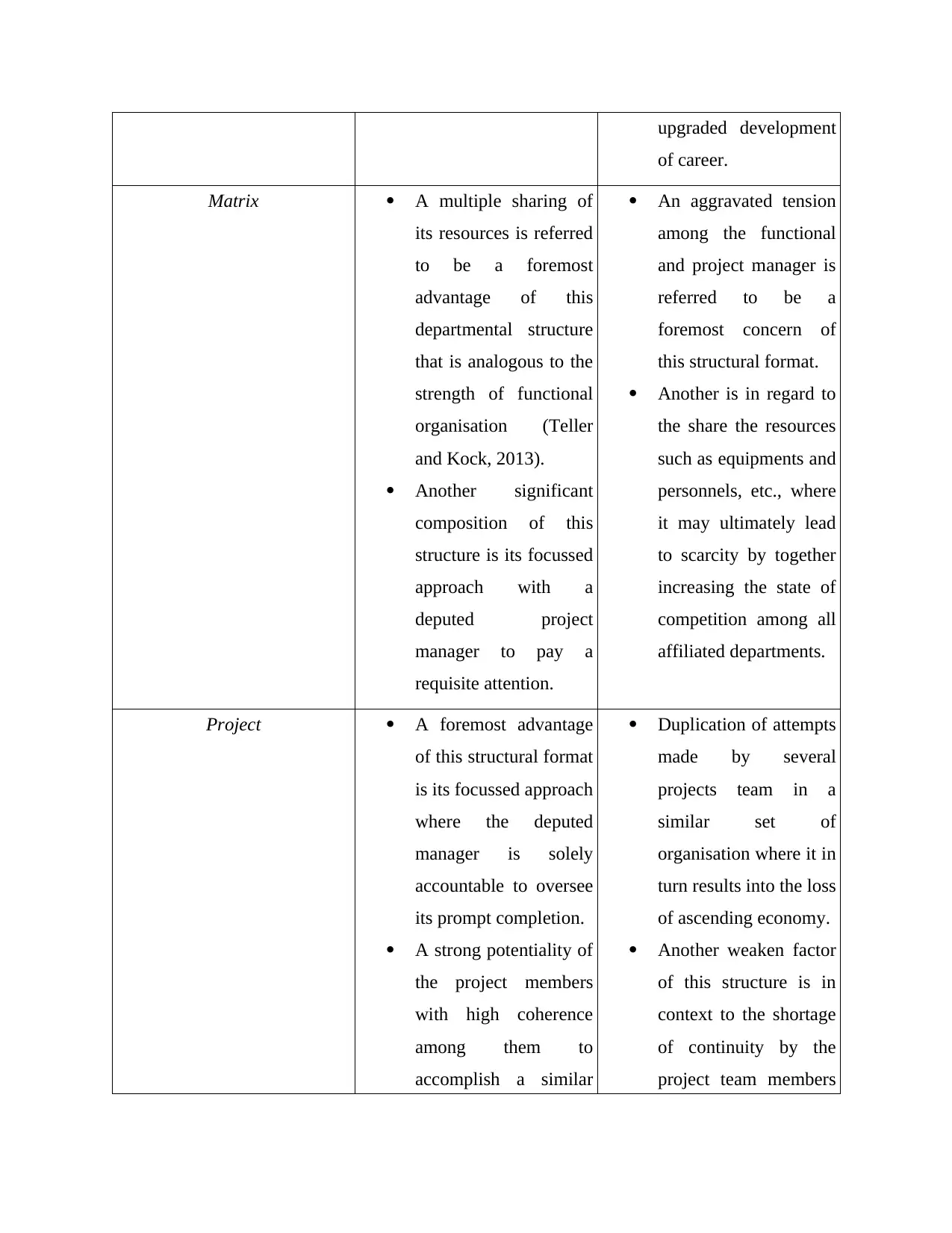
upgraded development
of career.
Matrix A multiple sharing of
its resources is referred
to be a foremost
advantage of this
departmental structure
that is analogous to the
strength of functional
organisation (Teller
and Kock, 2013).
Another significant
composition of this
structure is its focussed
approach with a
deputed project
manager to pay a
requisite attention.
An aggravated tension
among the functional
and project manager is
referred to be a
foremost concern of
this structural format.
Another is in regard to
the share the resources
such as equipments and
personnels, etc., where
it may ultimately lead
to scarcity by together
increasing the state of
competition among all
affiliated departments.
Project A foremost advantage
of this structural format
is its focussed approach
where the deputed
manager is solely
accountable to oversee
its prompt completion.
A strong potentiality of
the project members
with high coherence
among them to
accomplish a similar
Duplication of attempts
made by several
projects team in a
similar set of
organisation where it in
turn results into the loss
of ascending economy.
Another weaken factor
of this structure is in
context to the shortage
of continuity by the
project team members
of career.
Matrix A multiple sharing of
its resources is referred
to be a foremost
advantage of this
departmental structure
that is analogous to the
strength of functional
organisation (Teller
and Kock, 2013).
Another significant
composition of this
structure is its focussed
approach with a
deputed project
manager to pay a
requisite attention.
An aggravated tension
among the functional
and project manager is
referred to be a
foremost concern of
this structural format.
Another is in regard to
the share the resources
such as equipments and
personnels, etc., where
it may ultimately lead
to scarcity by together
increasing the state of
competition among all
affiliated departments.
Project A foremost advantage
of this structural format
is its focussed approach
where the deputed
manager is solely
accountable to oversee
its prompt completion.
A strong potentiality of
the project members
with high coherence
among them to
accomplish a similar
Duplication of attempts
made by several
projects team in a
similar set of
organisation where it in
turn results into the loss
of ascending economy.
Another weaken factor
of this structure is in
context to the shortage
of continuity by the
project team members
⊘ This is a preview!⊘
Do you want full access?
Subscribe today to unlock all pages.

Trusted by 1+ million students worldwide
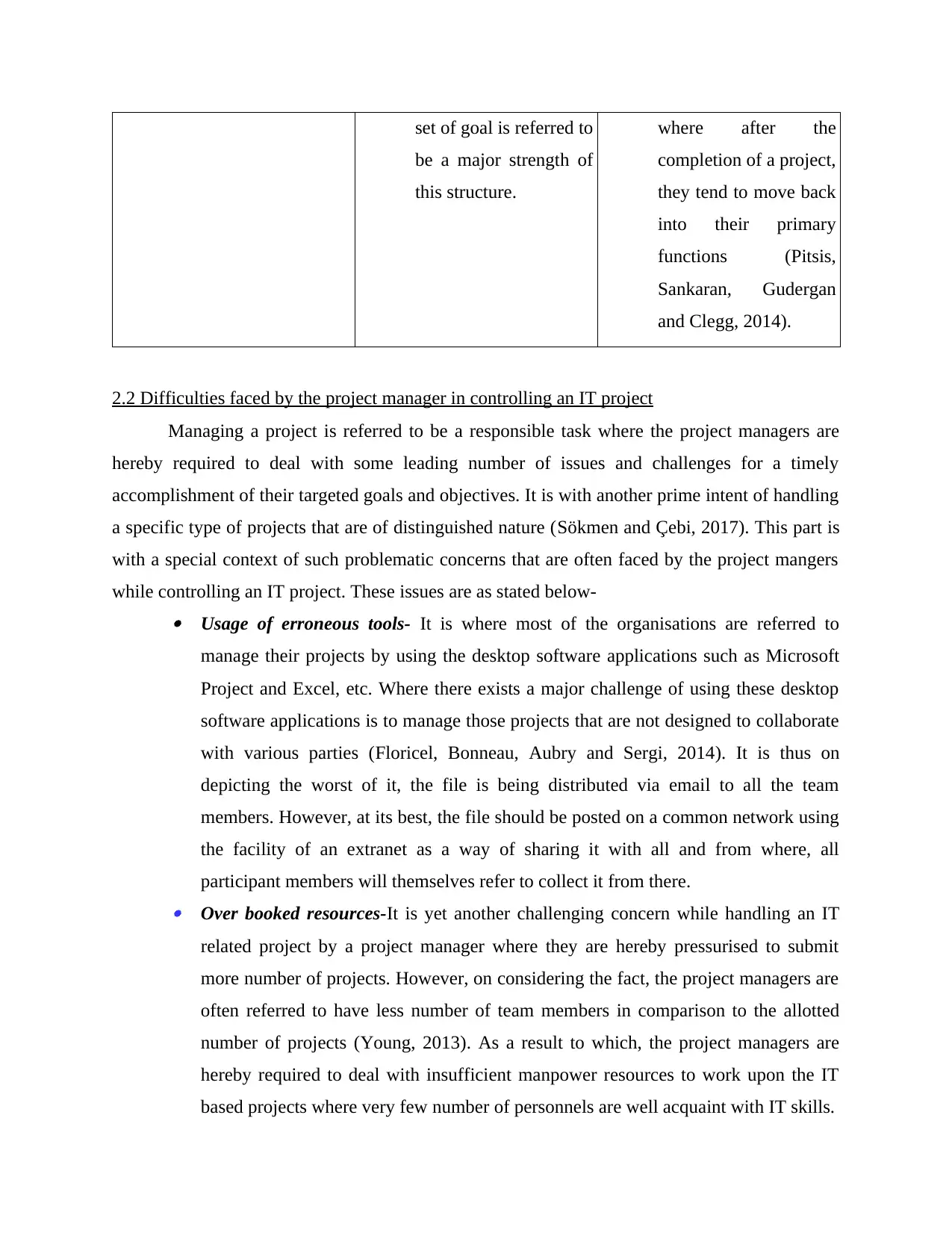
set of goal is referred to
be a major strength of
this structure.
where after the
completion of a project,
they tend to move back
into their primary
functions (Pitsis,
Sankaran, Gudergan
and Clegg, 2014).
2.2 Difficulties faced by the project manager in controlling an IT project
Managing a project is referred to be a responsible task where the project managers are
hereby required to deal with some leading number of issues and challenges for a timely
accomplishment of their targeted goals and objectives. It is with another prime intent of handling
a specific type of projects that are of distinguished nature (Sökmen and Çebi, 2017). This part is
with a special context of such problematic concerns that are often faced by the project mangers
while controlling an IT project. These issues are as stated below-
Usage of erroneous tools- It is where most of the organisations are referred to
manage their projects by using the desktop software applications such as Microsoft
Project and Excel, etc. Where there exists a major challenge of using these desktop
software applications is to manage those projects that are not designed to collaborate
with various parties (Floricel, Bonneau, Aubry and Sergi, 2014). It is thus on
depicting the worst of it, the file is being distributed via email to all the team
members. However, at its best, the file should be posted on a common network using
the facility of an extranet as a way of sharing it with all and from where, all
participant members will themselves refer to collect it from there.
Over booked resources-It is yet another challenging concern while handling an IT
related project by a project manager where they are hereby pressurised to submit
more number of projects. However, on considering the fact, the project managers are
often referred to have less number of team members in comparison to the allotted
number of projects (Young, 2013). As a result to which, the project managers are
hereby required to deal with insufficient manpower resources to work upon the IT
based projects where very few number of personnels are well acquaint with IT skills.
be a major strength of
this structure.
where after the
completion of a project,
they tend to move back
into their primary
functions (Pitsis,
Sankaran, Gudergan
and Clegg, 2014).
2.2 Difficulties faced by the project manager in controlling an IT project
Managing a project is referred to be a responsible task where the project managers are
hereby required to deal with some leading number of issues and challenges for a timely
accomplishment of their targeted goals and objectives. It is with another prime intent of handling
a specific type of projects that are of distinguished nature (Sökmen and Çebi, 2017). This part is
with a special context of such problematic concerns that are often faced by the project mangers
while controlling an IT project. These issues are as stated below-
Usage of erroneous tools- It is where most of the organisations are referred to
manage their projects by using the desktop software applications such as Microsoft
Project and Excel, etc. Where there exists a major challenge of using these desktop
software applications is to manage those projects that are not designed to collaborate
with various parties (Floricel, Bonneau, Aubry and Sergi, 2014). It is thus on
depicting the worst of it, the file is being distributed via email to all the team
members. However, at its best, the file should be posted on a common network using
the facility of an extranet as a way of sharing it with all and from where, all
participant members will themselves refer to collect it from there.
Over booked resources-It is yet another challenging concern while handling an IT
related project by a project manager where they are hereby pressurised to submit
more number of projects. However, on considering the fact, the project managers are
often referred to have less number of team members in comparison to the allotted
number of projects (Young, 2013). As a result to which, the project managers are
hereby required to deal with insufficient manpower resources to work upon the IT
based projects where very few number of personnels are well acquaint with IT skills.
Paraphrase This Document
Need a fresh take? Get an instant paraphrase of this document with our AI Paraphraser
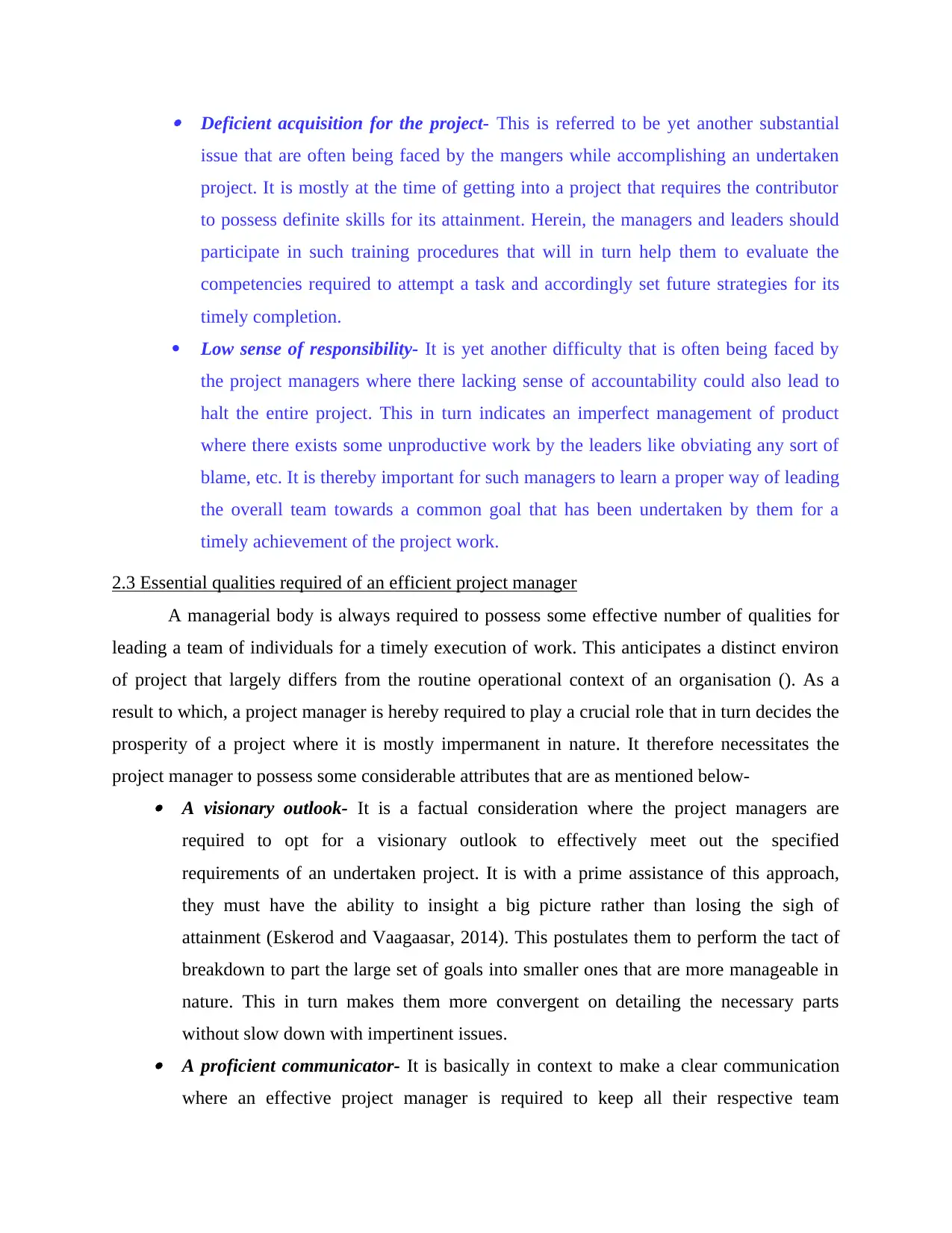
Deficient acquisition for the project- This is referred to be yet another substantial
issue that are often being faced by the mangers while accomplishing an undertaken
project. It is mostly at the time of getting into a project that requires the contributor
to possess definite skills for its attainment. Herein, the managers and leaders should
participate in such training procedures that will in turn help them to evaluate the
competencies required to attempt a task and accordingly set future strategies for its
timely completion.
Low sense of responsibility- It is yet another difficulty that is often being faced by
the project managers where there lacking sense of accountability could also lead to
halt the entire project. This in turn indicates an imperfect management of product
where there exists some unproductive work by the leaders like obviating any sort of
blame, etc. It is thereby important for such managers to learn a proper way of leading
the overall team towards a common goal that has been undertaken by them for a
timely achievement of the project work.
2.3 Essential qualities required of an efficient project manager
A managerial body is always required to possess some effective number of qualities for
leading a team of individuals for a timely execution of work. This anticipates a distinct environ
of project that largely differs from the routine operational context of an organisation (). As a
result to which, a project manager is hereby required to play a crucial role that in turn decides the
prosperity of a project where it is mostly impermanent in nature. It therefore necessitates the
project manager to possess some considerable attributes that are as mentioned below- A visionary outlook- It is a factual consideration where the project managers are
required to opt for a visionary outlook to effectively meet out the specified
requirements of an undertaken project. It is with a prime assistance of this approach,
they must have the ability to insight a big picture rather than losing the sigh of
attainment (Eskerod and Vaagaasar, 2014). This postulates them to perform the tact of
breakdown to part the large set of goals into smaller ones that are more manageable in
nature. This in turn makes them more convergent on detailing the necessary parts
without slow down with impertinent issues. A proficient communicator- It is basically in context to make a clear communication
where an effective project manager is required to keep all their respective team
issue that are often being faced by the mangers while accomplishing an undertaken
project. It is mostly at the time of getting into a project that requires the contributor
to possess definite skills for its attainment. Herein, the managers and leaders should
participate in such training procedures that will in turn help them to evaluate the
competencies required to attempt a task and accordingly set future strategies for its
timely completion.
Low sense of responsibility- It is yet another difficulty that is often being faced by
the project managers where there lacking sense of accountability could also lead to
halt the entire project. This in turn indicates an imperfect management of product
where there exists some unproductive work by the leaders like obviating any sort of
blame, etc. It is thereby important for such managers to learn a proper way of leading
the overall team towards a common goal that has been undertaken by them for a
timely achievement of the project work.
2.3 Essential qualities required of an efficient project manager
A managerial body is always required to possess some effective number of qualities for
leading a team of individuals for a timely execution of work. This anticipates a distinct environ
of project that largely differs from the routine operational context of an organisation (). As a
result to which, a project manager is hereby required to play a crucial role that in turn decides the
prosperity of a project where it is mostly impermanent in nature. It therefore necessitates the
project manager to possess some considerable attributes that are as mentioned below- A visionary outlook- It is a factual consideration where the project managers are
required to opt for a visionary outlook to effectively meet out the specified
requirements of an undertaken project. It is with a prime assistance of this approach,
they must have the ability to insight a big picture rather than losing the sigh of
attainment (Eskerod and Vaagaasar, 2014). This postulates them to perform the tact of
breakdown to part the large set of goals into smaller ones that are more manageable in
nature. This in turn makes them more convergent on detailing the necessary parts
without slow down with impertinent issues. A proficient communicator- It is basically in context to make a clear communication
where an effective project manager is required to keep all their respective team
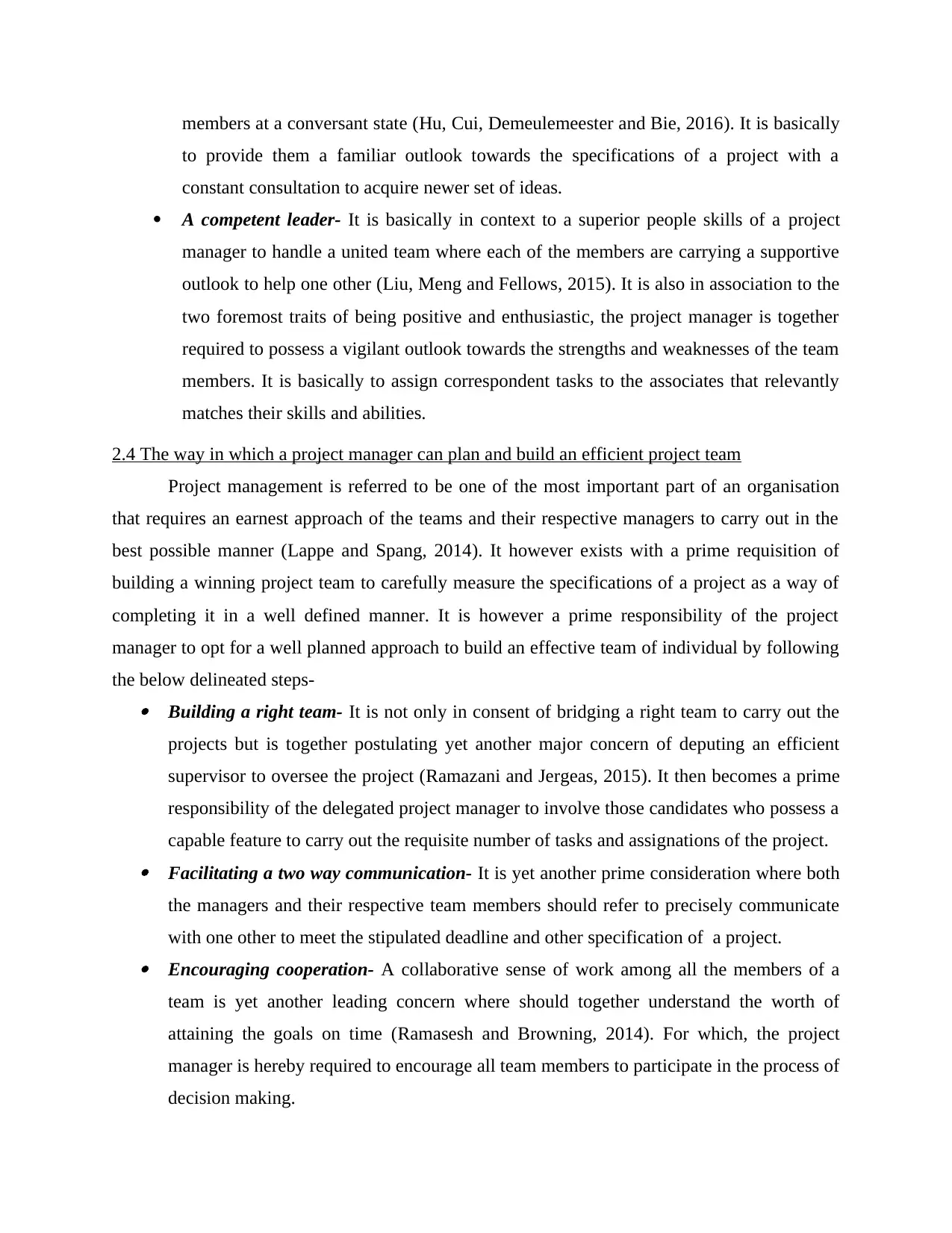
members at a conversant state (Hu, Cui, Demeulemeester and Bie, 2016). It is basically
to provide them a familiar outlook towards the specifications of a project with a
constant consultation to acquire newer set of ideas.
A competent leader- It is basically in context to a superior people skills of a project
manager to handle a united team where each of the members are carrying a supportive
outlook to help one other (Liu, Meng and Fellows, 2015). It is also in association to the
two foremost traits of being positive and enthusiastic, the project manager is together
required to possess a vigilant outlook towards the strengths and weaknesses of the team
members. It is basically to assign correspondent tasks to the associates that relevantly
matches their skills and abilities.
2.4 The way in which a project manager can plan and build an efficient project team
Project management is referred to be one of the most important part of an organisation
that requires an earnest approach of the teams and their respective managers to carry out in the
best possible manner (Lappe and Spang, 2014). It however exists with a prime requisition of
building a winning project team to carefully measure the specifications of a project as a way of
completing it in a well defined manner. It is however a prime responsibility of the project
manager to opt for a well planned approach to build an effective team of individual by following
the below delineated steps- Building a right team- It is not only in consent of bridging a right team to carry out the
projects but is together postulating yet another major concern of deputing an efficient
supervisor to oversee the project (Ramazani and Jergeas, 2015). It then becomes a prime
responsibility of the delegated project manager to involve those candidates who possess a
capable feature to carry out the requisite number of tasks and assignations of the project. Facilitating a two way communication- It is yet another prime consideration where both
the managers and their respective team members should refer to precisely communicate
with one other to meet the stipulated deadline and other specification of a project. Encouraging cooperation- A collaborative sense of work among all the members of a
team is yet another leading concern where should together understand the worth of
attaining the goals on time (Ramasesh and Browning, 2014). For which, the project
manager is hereby required to encourage all team members to participate in the process of
decision making.
to provide them a familiar outlook towards the specifications of a project with a
constant consultation to acquire newer set of ideas.
A competent leader- It is basically in context to a superior people skills of a project
manager to handle a united team where each of the members are carrying a supportive
outlook to help one other (Liu, Meng and Fellows, 2015). It is also in association to the
two foremost traits of being positive and enthusiastic, the project manager is together
required to possess a vigilant outlook towards the strengths and weaknesses of the team
members. It is basically to assign correspondent tasks to the associates that relevantly
matches their skills and abilities.
2.4 The way in which a project manager can plan and build an efficient project team
Project management is referred to be one of the most important part of an organisation
that requires an earnest approach of the teams and their respective managers to carry out in the
best possible manner (Lappe and Spang, 2014). It however exists with a prime requisition of
building a winning project team to carefully measure the specifications of a project as a way of
completing it in a well defined manner. It is however a prime responsibility of the project
manager to opt for a well planned approach to build an effective team of individual by following
the below delineated steps- Building a right team- It is not only in consent of bridging a right team to carry out the
projects but is together postulating yet another major concern of deputing an efficient
supervisor to oversee the project (Ramazani and Jergeas, 2015). It then becomes a prime
responsibility of the delegated project manager to involve those candidates who possess a
capable feature to carry out the requisite number of tasks and assignations of the project. Facilitating a two way communication- It is yet another prime consideration where both
the managers and their respective team members should refer to precisely communicate
with one other to meet the stipulated deadline and other specification of a project. Encouraging cooperation- A collaborative sense of work among all the members of a
team is yet another leading concern where should together understand the worth of
attaining the goals on time (Ramasesh and Browning, 2014). For which, the project
manager is hereby required to encourage all team members to participate in the process of
decision making.
⊘ This is a preview!⊘
Do you want full access?
Subscribe today to unlock all pages.

Trusted by 1+ million students worldwide
1 out of 20
Related Documents
Your All-in-One AI-Powered Toolkit for Academic Success.
+13062052269
info@desklib.com
Available 24*7 on WhatsApp / Email
![[object Object]](/_next/static/media/star-bottom.7253800d.svg)
Unlock your academic potential
Copyright © 2020–2025 A2Z Services. All Rights Reserved. Developed and managed by ZUCOL.





